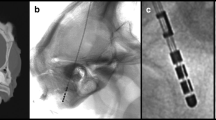Abstract
Deep brain stimulation (DBS) efficacy is related to optimal electrode placement. Several authors have quantified brain shift related to surgical targeting; yet, few reports document and discuss the effects of brain shift after insertion. Objective: To quantify brain shift and electrode displacement after device insertion. Twelve patients were retrospectively reviewed, and one post-operative MRI and one time-delayed CT were obtained for each patient and their implanted electrodes modeled in 3D. Two competing methods were employed to measure the electrode tip location and deviation from the prototypical linear implant after the resolution of acute surgical changes, such as brain shift and pneumocephalus. In the interim between surgery and a pneumocephalus free postoperative scan, electrode deviation was documented in all patients and all electrodes. Significant shift of the electrode tip was identified in rostral, anterior, and medial directions (p < 0.05). Shift was greatest in the rostral direction, measuring an average of 1.41 mm. Brain shift and subsequent electrode displacement occurs in patients after DBS surgery with the reversal of intraoperative brain shift. Rostral displacement is on the order of the height of one DBS contact. Further investigation into the time course of intraoperative brain shift and its potential effects on procedures performed with rigid and non-rigid devices in supine and semi-sitting surgical positions is needed.










Similar content being viewed by others
References
D’Haese, P. F., S. Pallavaram, et al. Clinical accuracy of a customized stereotactic platform for deep brain stimulation after accounting for brain shift. Stereotact. Funct. Neurosurg. 88(2):81–87, 2010.
Deuschl, G., C. Schade-Brittinger, et al. A randomized trial of deep-brain stimulation for Parkinson’s disease. N. Engl. J. Med. 355(9):896–908, 2006.
Goldstein, S. R., and M. Saloman. Mechanical factors in the design of chronic recording intracortical microelectrodes. IEEE Trans. Biomed. Eng. 20(4):260–269, 1973.
Halpern, C. H., S. F. Danish, et al. Brain shift during deep brain stimulation surgery for Parkinson’s disease. Stereotact. Funct. Neurosurg. 86(1):37–43, 2008.
Hess, A. E., J. R. Capadona, et al. Development of a stimuli-responsive polymer nanocomposite toward biologically optimized, MEMS-based neural probes. J. Micromech. Microeng. 21(1):1–9, 2011.
Larson, P. S. Deep brain stimulation for psychiatric disorders. Neurotherapeutics 5(1):50–58, 2008.
LeWitt, P. A., A. R. Rezai, et al. AAV2-GAD gene therapy for advanced Parkinson’s disease a double-blind, sham-surgery controlled, randomized trial. Lancet Neurol 10(1):309–319, 2011.
Miyagi, Y., F. Shima, et al. Brain shift: an error factor during implantation of deep brain stimulation electrodes. J. Neurosurg. 107(5):989–997, 2007.
Papavassiliou, E., G. Rau, et al. Thalamic deep brain stimulation for essential tremor: relation of lead location to outcome. Neurosurgery 54(5):1120–1129, 2004; (discussion 1129-1130).
Petersen, E., E. Holl, et al. Minimizing brain shift in stereotactic functional neurosurgery. Neurosurgery 67(3):213–221, 2010.
Richardson, M. R., A. P. Kells, et al. Interventional MRI-guided putaminal delivery of AAV2-GDNF for a planned clinical trial in Parkinson’s disease. Am. Soc. Gene Cell Ther 19(1):1048–1057, 2011.
Sampson, J. H., G. Archer, et al. Poor drug distribution as a possible explanation for the results of the PRECISE trial. J. Neurosurg. 113(2):301–309, 2010.
Sampson, J. H., M. L. Brady, et al. Intracerebral infusate distribution by convection-enhanced delivery in humans with malignant gliomas: descriptive effects of target anatomy and catheter positioning. Neurosurgery 60(2 Suppl 1):ONS89–ONS98, 2007.
Starr, P. A. Placement of deep brain stimulators into the subthalamic nucleus or Globus pallidus internus: technical approach. Stereotact. Funct. Neurosurg. 79(3–4):118–145, 2002.
Starr, P. A., A. J. Martin, et al. Implantation of deep brain stimulator electrodes using interventional MRI. Neurosurg. Clin. N. Am. 20(2):207–217, 2009.
Subbaroyan, J., D. C. Martin, et al. A finite-element model of the mechanical effects of implantable microelectrodes in the cerebral cortex. J. Neural Eng. 2(1):103–113, 2005.
Van den Munckhof, P., M. Fiorella Contarino, et al. Postoperative curving and upward displacement of deep brain stimulation electrodes caused by brain shift. Neurosurgery 67(1):49–54, 2010.
Acknowledgments
The authors would like to thank Heather Rusk, Ethan Brodsky, and Angelica Hinchman of the University of Wisconsin Neurological Surgery Department for their helpful comments on the manuscript. Additionally, we acknowledge Media Solutions, University of Wisconsin for the figure they prepared for this manuscript. This work was supported in part by The Kinetics Foundation and institutional startup funds.
Author information
Authors and Affiliations
Corresponding author
Additional information
Associate Editor Jeffrey L. Duerk oversaw the review of this article.
Rights and permissions
About this article
Cite this article
Sillay, K.A., Kumbier, L.M., Ross, C. et al. Perioperative Brain Shift and Deep Brain Stimulating Electrode Deformation Analysis: Implications for rigid and non-rigid devices. Ann Biomed Eng 41, 293–304 (2013). https://doi.org/10.1007/s10439-012-0650-0
Received:
Accepted:
Published:
Issue Date:
DOI: https://doi.org/10.1007/s10439-012-0650-0




